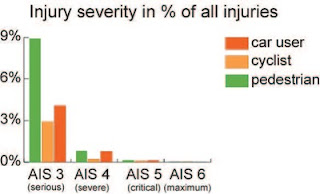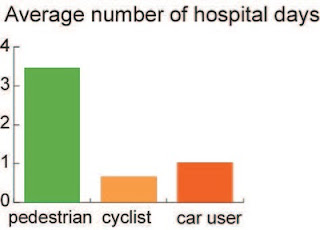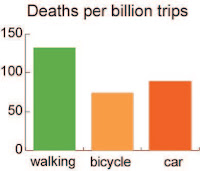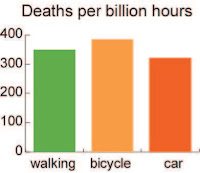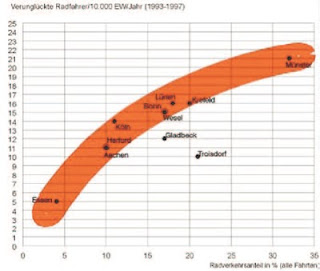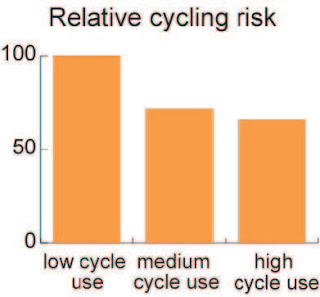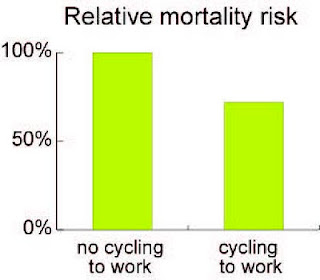

It’s a pleasure for Copenhagenize to publish an article by one of Denmark’s great thinkers regarding bicycle culture. Thomas Krag has a Masters degree in Chemistry but for many years he has been closely involved with Danish and international bicycle culture. He was the head of the Danish Cyclists’ Federation [DCF] from 1986-2000 and he now runs his own consultancy Thomas Krag Mobility Advice.
Thomas' Cycling, Safety and Health article discusses risk perception and how we (often wrongly) measure risk and goes on to highlight how safe cycling is as well as showing the health benefits of having high numbers of bicycle users/Citizen Cyclists in a city or country.
Thomas' work has been a great inspiration to me over the past four years. He has been a bit off the bicycle radar for a time, but his rationality and academic approach is much needed in Denmark and internationally.Thomas Krag has tremendous knowledge and experience in all aspects of bicycle culture and statistics. We've been planning on publishing this article of his about Cycling, safety and health for a while and today we got it done. It's long but worth the read. The .pdf of this article is available from the European Cyclists' Federation's website right here.
Here comes the blog version. Click on the graphs for larger versions.Cycling, Safety & Health
by Thomas KragIntroduction
Cycling is free of pollution and healthy for the user. The bicycle is probably the most sustainable transport means yet invented. Moreover, cycling has a significant potential to replace car use in cities, where many car trips are short. Based on elementary risk figures, however, cycling seems to be unsafe as compared to driving, which is widely used as an argument against bicycle promotion.It can however be questioned which risk measures are relevant to use. Areas with high levels of cycling seem to be safer for cyclists, as well as other road users, than areas dominated by cars. Statistical evidence, moreover, suggests that a non car-based lifestyle with lots of cycling can be associated with a smaller risk of getting killed in traffic than a car-based lifestyle. On top of this positive health benefits from cycling far outweigh the negative health effects from cycling accidents.The matters are discussed in more detail below. It is concluded, that cycle promotion is fully defendable from an ethical point of view, while it is more disputable to discuss traffic safety in isolation from other health effects of the traffic system.A few words on terminology
Cyclists are often described as "soft", "weak" or "vulnerable" road users. Seen as individuals, regular bicycle users are however usually tougher than those who do not benefit from regular physical exercise. The term "unprotected road users" therefore gives a better description of the fact that cyclists are subject to severe injuries in crashes.Care should also be taken when using the term "cyclist". In the following article, the term is used solely for a traffic user, who is riding a bicycle in a given moment. Those who sometimes or often cycle, are called bicycle users.Risk
The injury risk is often calculated and used in connection with engineering considerations. Generally, the risk is calculated as the number of undesired incidents (accidents, injuries, injured persons, deaths) divided by a measure for the amount of transport involved (kilometres, trips, time).This opens for calculating a lot of different figures, and a good degree of care should be taken in which of them to be used in which connection. Usually the number of injured, severely injured or killed persons is used for risk calculations. This is preferable for using the number of accidents, as each accident can involve one ore several persons. One person can, on the other hand, be hit by one or more injuries in one and the same accident, and for this reason the number of injured persons is usually a more relevant figure than the number of injuries.Traffic injuries are of a very different nature. Cycling is known to cause several injuries out of which there is a relatively smaller number of serious, severe and critical injuries than found for other transport means. This is reflected in a smaller number of hospital bed days per person treated at the hospital casualty department [1]. The tendencies are shown in the graphs below.Data on traffic injuries from a hospital casualty department [1]. AIS is "Abbreviated Injury Scale", the share in each road user group is shown.
The usual accident statistics is known to have a significant under-reporting of cycling injuries [1], part of the reason being that many single accidents with cyclists are never reported to the police.
This all makes it a difficult task to make a fair comparison of injury risk figures calculated for different transport means. When it comes to the number of killed persons, however, the accident statistics is usually reliable. By using fatalities one also avoids the discussion on the severity of the injuries and their impact on the persons involved.The figure used in the denominator for risk calculations is often the number of kilometres travelled. This can be relevant for some purposes but disputable for others. The number of kilometres travelled has been growing year by year for most western societies while the time spent in transport and the number of trips generally has been found to be stable. When calculating risk on a societal level the latter figures will thus be a better choice than the number of kilometres travelled.The following graphs show the difference when calculating the person's own risk of being killed in transport for walking, cycling and car driving using respectively distance, number of trips and time as measure for the amount of transport [2]. From the graphs one can conclude that only when kilometres is used as a measure, significant risk differences between the three modes appear. Cycling in this case turns out to be 4-5 times as risky as car use, and walking more than 10 times as risky. For risk measured per trip or per time spent in transport the three modes walking, cycling and car driving are not differing significantly.The risk imposed on other road users is not taken into consideration here, which would render the car relatively more risky than the other means in the graphs shown above. If, instead of fatalities, injuries had been used as a measure, cycling would have turned out to be relatively more risky than the other transport means in the graphs above. This is due to the fact that only a relatively smaller part of the injured cyclists are killed in the traffic accidents.The risk is not a constant
There is a totally different problem associated with the calculation of transport risk as, say, number of severe injuries per kilometre travelled. Thus, such risk-figures often lead to the idea that the number of injuries can be forecasted from knowledge of the kilometres to be travelled.For the traffic system as such this is known not to be the case. Far the majority of western countries have experienced a decrease in the total number of injuries in transport at the same time as the number of kilometres travelled has increased significantly. Examples are shown by the graphs below [3] [4].Top Road traffic growth in the EU (including GDR before 1990) and its prognosis to 2010 [3].
Bottom: Fatality development in the EU (including GDR before 1990) and its prognosis to 2010 [3].
Fatality risk per 100,000 inhabitants in several countries. Source: IRTAD [4]. Click for a larger version. Sorry that it's grainy.This shows two things:1. Several countries have been successful in reducing the risk for being killed in traffic accidents.2. The risk measured as fatalities per kilometre travelled can not be used for forecasting traffic deaths over a span of years.
More cycling is associated with a smaller accident risk
If the risk of cycling could be used for forecasting bicycle injuries from the amount of cycle traffic, one would expect a proportional increase in traffic accidents, if bicycle traffic was promoted successfully.Several studies however conclude that the risk of cycling decrease the more cycling there is [5] [6] [7] [8] [9] [10]. This means that an increase in cycling may be associated with an increase in the total number of cycling injuries, but that the increase will be less than what would be predicted from the initial risk.The graphs below reflect some of the findings.Top: Risk of cycling tends to be smallest in the countries with the most cycling [10].
Bottom: Walking and cycling in 68 Californian cities in 2000 [9].
Top: Selected cities in Nordrhein-Westphalen, Germany. The relative number of injured cyclists versus the amount of bicycle traffic. The increase is not proportional, and risk decreases with bicycle use [6].
Bottom: Relation between cycling use and cyclists' injury risk, according to Dutch figures [8].The inverse relation between cycling and cyclists' risk is usually explained by motorists' behaviour: If there are many people cycling, the motorists will also expect to find them in the traffic and take better care not to collide with them. Another reason could be that conditions, generally, are safer in those places where a lot of cycling occurs. It is thus known that more care is taken for cyclists in the traffic planning in the countries and cities with many cyclists.A single reference suggests that the behaviour of the cyclists could also play a role [11]. It is to be expected that the risk of cycling accidents is smaller for experienced bicycle users than for the less experienced ones. One could also expect a generally higher experience level for the bicycle users in areas with a lot of cycling. Only a little research in this area is, however, known.
Cyclists' accident risk versus experience [11].Whatever the explanation is, the findings demonstrate that the risk of cycling varies a lot and generally decreases with increased cycle traffic.
More cycling and less cycling accidents
Model cycling cities in Nordrhein-Westphalen, Germany. The number of seriously injured cyclists per 10.000 inhabitants per year (red columns) and the share of bicycle traffic (green columns) over a time span show for all cities fewer injuries and for all but one city more cycling [6].

Figures on cycling and cycling risk from Vienna 1980-1992 ("Unfallrisiko means "accident risk" and "Wege" means "trips"). Huge increase in cycling and an associated three fourth decrease in accident risk [12].
Bicycling in Netherlands 1980-1998. A 30% increase in cycle traffic is associated with a two-third reduction in risk, e.g. a decrease of the total number of fatal cycling accidents [9].
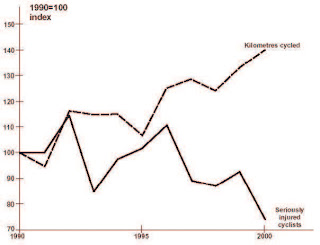
Copenhagen, Denmark, 1990-2000. The trend generally shows an increase of cycle traffic and a decrease in the number of seriously injured cyclists [13].In the graphs above attention is not paid to the injury risk of other roads users. It can however be assumed, that increase of cycling will be associated with a decrease of the number of injuries of other road users, part of the reason being a smaller number of people in the other road user groups (since there are more bicycle users), another part being a reduced speed level and a more friendly traffic environment.It is beyond the scope of this article to discuss what safety measures were taken in the above mentioned cities. In none of the examples, however, increased cycle helmet wearing has made a notable contribution to the reduced injury numbers. The examples show that it is not only possible to achieve a reduction in cycling risk in connection with a raised cycle use, it is even possible to increase cycle use and reduce the absolute number of injured cyclists at the same time. Should a calculated cycling risk be used for forecasting the number of bicycle injuries, one would have to deal with a negative, marginal risk in these examples.This all adds to the fact that the risk of cycling can be reduced by increasing cycle use. If, however, the resulting risk is still bigger than the risk of driving, one can still question the sensibility of cycling.
A non-car lifestyle is not necessarily unsafe
With a higher risk of cycling than driving, one should from a personal point of view expect to be subject to a higher risk of traffic accidents when basing one's life on cycling than when primarily going by car. It is, however, somewhat theoretical to assume the majority of car trips of a normal person to be replaced by bicycle trips. A typical cycle trip is 3-4 km, while a notable part of the car trips have a length of at least 10 km, a distance which a few but the most dedicated bicycle users are ready to cycle.Those who use bicycle for their shorter trips will, if they have no car available, typically use public transport for the longer distances. Since public transport is a safe mode - much safer than the car - this combination might turn out to be as safe as using a car for a long trip.Some examples based on simple but realistic figures are shown in the table. PT is used as an abbreviation for public transport. The last example represents a skilled public transport user, who saves time by biking to a train station, thereby not having to wait for a bus for the first part of the trip. While it - from a personal risk point of view - apparently seems to be beneficial to choose the car for the short trip, combinations of walking, cycling and public transport produce safer results for the long trips.The phenomenon can be studied in greater detail using travel survey data. Danish data include the number of cars available at the household, which enables a separation of the population into groups with significantly different lifestyles as far as bicycle and car use is concerned. In the population studied, people aged 16-74 years, there were respectively 22, 61 and 17 per cent living at households with no car, one car, and more than one car available.Not so surprisingly, the bicycle and public transport was found to be used more and the car much less in households without a car. What is more surprising, is that when multiplying the average number of kilometres travelled with the per kilometre fatality risk, this sums up to be a higher figure in the least cycling part of the population.The graphs show the daily average transport distributed on the various means, and the resulting risk of being killed in transport, with the contribution from the different means shown. "Other" is a mixture of moped, motorbike, taxi, ferry and airplane. Public transport has a zero contribution to the fatality risk. The figures are from 1997 [14]. From the graph above it is obvious, that those without a car travel less kilometres per day, and thus - if mobility is set equal to kilometres - can be said to be less "mobile". They are, however, if the number of trips is used as a mobility measure, almost as mobile as those with cars, as shown in the graph below: The way of calculating can of course be discussed. The method is safe for under-reporting of transport means in the household surveys, if the under-reporting is the same for the different groups compared. It assumes, however, that the risk is constant among the population. This is not the case. Long driving trips, with the major part usually taking place on the safest roads, will for example be safer than the average driving trip. One could also argue that those who cycle or drive a lot will get experienced, and therefore will have a smaller risk than the average (which, as stated previously, has actually been shown to be the case for bicycle users). It is however most probable that the general picture will persist a more thorough analysis.One can thus conclude that it is safest not to base one's life on a car, if you live in Denmark. If, on the other hand, one already has and needs a car, it seems still to be unwise to switch some of the shorter trips from car to bicycle. But is it so?Cycling and health
Besides safety, pollution is a point of concern. It is regarded unhealthy to cycle in an urban atmosphere. It seems, however, that there is no reason to be especially concerned about this. A number of studies indicate that cyclists are not more exposed to dangerous fumes than other road users15, 16,17, one of the reasons for this being, that the concentration of exhaust fumes is higher inside cars than where cyclists breathe. Studies indicate that cyclists are less exposed to urban pollution than carusers. The example shown is a Dutch study [17].From a societal point of view cycling is desirable: No pollution, little demand for space, independent transport of children etc.Safety remains however an issue of concern. What is stated in the previous paragraphs indicates that it is possible to reduce the injury risk of cycling substantially, and that successful promotion of cycling in itself seems to contribute to such a risk-reduction. In most cases, however, one will still find that cycling's safety risk is greater than the risk of car use. Unless a total change of lifestyle is achieved, and long car journeys are switched to public transport, shift from car to bicycle can result in an increased personal injury risk.From a strict safety point of view one would consequently disrecommend cycle promotion, unless cycle use could be made as safe as car use. So cycling immediately seems to be a social dilemma: It is beneficial for the society but disadvantageous for the user.The user, however, has positive health benefits of cycling due to the physical exercise, he or she gets. Piles of research reports point out the sedentary lifestyle as a risk factor, and about as much research find that even moderate physical exercise as part of the daily life will give significant health benefits for the individual. For the same reason several national health programmes recommend physical activity as a health promoting activity. Norway can be chosen as example [18].Attempts have been made to compare the positive health effects from cycling with the negative health consequences of bicycle accidents. Early studies conclude, that the positive health effects are 10-20 times as important as the negative accident impacts [19] [20]. Later findings using epidemiological data confirm a significant, positive net-effect on health from cycling to work [21].Relative risk of mortality adjusted for numerous factors (age, sex, education, smoking etc.), in dependence of cycling to work, calculated from Danish epidemiological data. Regular cycle users have 28% less risk of dying, even though they probably have an increased risk of cycling accidents [21].A Norwegian cost-benefit study on infrastructure investments concludes provisions for walking and cycling to be much more cost effective than traditional car infrastructure, the main positive component being positive health effects from walking and cycling [22].A study of the cycling city of Odense, Denmark, suggests significant public savings to be a result of local cycle promotion activities. The savings in public paid maintenance allowances for employees being off work for health reasons were found to be bigger than the total investments in campaigns and infrastructure [23].Another study of the bicycle user behaviour in Odense finds, that those who cycle are also more physically active in other ways [24]. There is thus no reason to expect a person, who take up cycling, to compensate by becoming less physically active overall.
International health policies in favour of cycling
The convincing documentation for the connection between physical activity and health has lead to international agreement on favouring the physically active forms of transport, cycling and walking. The ministers and representatives of the European member states of WHO, the World Health Organization, signed a charter about transport, environment and health in London in 1999. According to the charter "we will promote safe and environmentally friendly cycling and walking by providing safe infrastructure and networks, implementing measures for traffic management, enforcing speed controls and speed limits that are appropriate to local circumstances, and designing roads and settlements taking into account the needs of pedestrians and cyclists." [25]It has thus been internationally accepted, that it is overall beneficial to promote cycling in a safe environment. Several activities have since then been carried out in the area of walking and cycling and health impact assessment of transport [26].Conclusions
There are reasons to be concerned about cyclists' safety, and one should be careful in providing a safe infrastructure for cyclists, whether this is in the form of separate cycle ways or by integrating cycle traffic in the already existing road network.Concerns should however not be exaggerated. The fatality risk of cycling per hour or per trip is not bigger than for car driving, and the contribution to traffic deaths from long car trips is considerable. The individual, who replaces the car with public transport and cycling, will be exposed to a reduced risk of being killed in traffic.It seems moreover to be an almost general law, that the risk of cycling is lowered the more cycling there is. Experience even in some cases shows a drop in the absolute number cycling injuries associated with an increase in cycling. When also the positive health benefits from physical exercise are taken into account,cycling will in any case turn out very positively. There is no reason to wait for a traffic safety per kilometre level as low as that for motoring, before one can promote cycling from an ethical point of view.There are, on the contrary, reasons to warn against a strictly sectoral approach to traffic safety. Traffic safety is a highly relevant concern of health impacts from the traffic system. If, however, one only takes the direct, negative health consequences from traffic accidents into account, one is missing the major part of the full picture.References
1 Accident Analysis Group: Accident victims treated at the A & E department, Odense University Hospital, Denmark, 1998-2000.2 Data used from Thomas Krag: Safer without the car, Velo-Australis 1996. The figures used are from Statistics Denmark 1992 for ages 16-74 years.3 Transport Safety Performance in the EU - a statistical overview. European Transport Safety Council, 2003
(http://www.etsc.be > reports).
4 IRTAD/BaSt 2003.5 Lars Ekman: On the treatment of flow in traffic safety analysis - a non-parametric approach applied on vulnerable road users. Doctorate, University of Lund, 1996:10.
6 Ministerium für Wirtschaft und Mittelstand, Energie und Verkehr des Landes Nordrhein-Westphalen, "Fahrradfreundliche Städte und Gemeinden in NRW - Maßnahmen- und Wirksamkeitsuntersuchung. Bericht, Städtedokumentation, Maßnahmendokumentation", 2001 (http://www.fahrradfreundlich.nrw.de > Marktplatz
> Literatur )7 Søren Underlien Jensen, DUMAS: safety of pedestrians and two-wheelers, Notat 51, Vejdirektoratet, København 1998.8 Otto van Boggelen & Frank Borgman: Hoog fietsgebruik good voor verkeersveiligheid. Report on "Fietsbalans", June 2003.9 P L Jacobsen. Safety in numbers: more walkers and bicyclists, safer walking and bicycling. Injury Prevention 2003; 9:205-209.10 Transport Demand of Modes not covered in International Transport Statistics, UITP/ European Cyclists’ Federation (ECF), December 1997 (data presented graphically are from 1994).11 Bikewest, Western Australia: Bike Ahead - Bicycle Strategy for the 21st Century. (http://www.dpi.wa.gov.au/cycling > Technical Publications)
12 VCÖ Verkehrsclub Österreich, "Strassen zum radfahren", Wissenschaft & Verkehr 2/1995, Wien 1995.13 Cycle Policy 2002-2012. Municipality of Copenhagen, Roads and Park Department, 2002 (www.vejpark.kk.dk > Byens trafik > Cyklernes by > City of Cyclists > Cycle Policy).
14 Thomas Krag, Transportmiddelvalg og ulykkesrisiko, Trafikdage i Aalborg 1999 (http://www.trafikdage.dk >Paper-arkiv > Trafikdage: 1999 > Trafiksikkerhed15 Waldman, M; Weiss, S; Articola, W: A Study of the Health Effects of Bicycling in an Urban Atmosphere. U.S. dept. of Transportation, 1977.16 Rank J, Folke J, Jespersen P H. Differences in cyclists and car drivers exposure to air pollution from traffic in the city of Copenhagen. Sci Total Environ 2001; 279: 131-6 (background report in Danish available at www.akira.ruc.dk/~mfg/PDF_files/FileTMRapport.pdf).
17 Van Wijnen/ Verhoeff/ Henk/ Van Bruggen: The exposure of cyclists, car drivers and pedestrians to traffic-related air-pollutants, Int. Arch. Occup. Environ. Health 67:187-193, 1995.18 Strømme SB, Anderssen SA, Hjermann I, Sundgot-Borgen J, Smeland S, Mæhlum S et al. Fysisk aktivitet og helse - anbefalinger. SEF-rapport nr. 2/2000 (Recommendations on Physical Activity and Health, Norwegian Council of Nutrition and Physical Activity).19 Thomas Krag: Safety - the Achilles' Heel for Cycling. Velo-city Conference in Copenhagen, 1989 (also available at www.thomaskrag.com > Foredrag og artikler)
20 British Medical Association /Mayer Hillman i bogen ”Cycling – Towards Health and Safety”, Oxford University Press, 199221 Andersen LB, Schnohr P, Schroll M, Hein HO: All-cause mortality associated with physical activity during leisure time, work, sports, and cycling to work. Arch Intern Med. 2000 Jun 12;160(11):1621-822 Kjartan Sælensminde: Gang- og sykkelvegnett i norske byer. Nytte- kostnadsanalyser inkludert helseeffekter og eksterne kostnader av motorisert vegtrafikk. TØI, Norway, Report 567/2002.23 Evaluering af Odense - Danmarks Nationale Cykelby. Odense Kommune, 2004 (www.cyclecity.dk > Mål og resultater)24 Jens Troelsen: Mobil på cykel - en refleksiv analyse af kvaliteter og barrierer for cykling som transportform. Ph.d. -afhandling, Institut for Idræt og Biomekanik, Syddansk Universitet, 2004.25 WHO, Charter on Transport, Environment and Health, signed in London 1999 (available at www.euro.who.int/document/peh-ehp/charter_transporte.pdf).26 See more at www.euro.who.int/transport.
